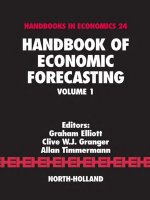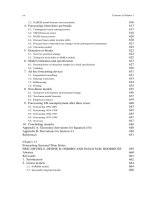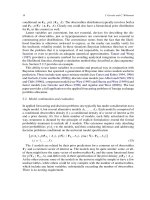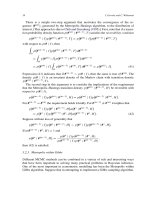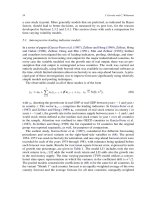Handbook of Economic Forecasting part 4 doc
Bạn đang xem bản rút gọn của tài liệu. Xem và tải ngay bản đầy đủ của tài liệu tại đây (113.9 KB, 10 trang )
4 J. Geweke and C. Whiteman
3.2.2. The Metropolis–Hastings algorithm
33
3.2.3. Metropolis within Gibbs 34
3.3. The full Monte 36
3.3.1. Predictive distributions and point forecasts 37
3.3.2. Model combination and the revision of assumptions 39
4. ’Twas not always so easy: A historical perspective 41
4.1. In the beginning, there was diffuseness, conjugacy, and analytic work 41
4.2. The dynamic linear model 43
4.3. The Minnesota revolution 44
4.4. After Minnesota: Subsequent developments 49
5. Some Bayesian forecasting models 53
5.1. Autoregressive leading indicator models 54
5.2. Stationary linear models 56
5.2.1. The stationary AR(p) model 56
5.2.2. The stationary ARMA(p, q) model 57
5.3. Fractional integration 59
5.4. Cointegration and error correction 61
5.5. Stochastic volatility 64
6. Practical experience with Bayesian forecasts 68
6.1. National BVAR forecasts: The Federal Reserve Bank of Minneapolis 69
6.2. Regional BVAR forecasts: economic conditions in Iowa 70
References 73
Abstract
Bayesian forecasting is a natural product of a Bayesian approach to inference. The
Bayesian approach in general requires explicit formulation of a model, and condition-
ing on known quantities, in order to draw inferences about unknown ones. In Bayesian
forecasting, one simply takes a subset of the unknown quantities to be future values of
some variables of interest. This chapter presents the principles of Bayesian forecasting,
and describes recent advances in computational capabilities for applying them that have
dramatically expanded the scope of applicability of the Bayesian approach. It describes
historical developments and the analytic compromises that were necessary prior to re-
cent developments, the application of the new procedures in a variety of examples, and
reports on two long-term Bayesian forecasting exercises.
Keywords
Markov chain Monte Carlo, predictive distribution, probability forecasting, simulation,
vector autoregression
Ch. 1: Bayesian Forecasting 5
JEL classification: C530, C110, C150
6 J. Geweke and C. Whiteman
in terms of forecasting ability, a good Bayesian will beat a non-Bayesian,
who will do better than a bad Bayesian.
[C.W.J. Granger (1986, p. 16)]
1. Introduction
Forecasting involves the use of information at hand – hunches, formal models, data, etc.
– to make statements about the likely course of future events. In technical terms, condi-
tional on what one knows, what can one say about the future? The Bayesian approach
to inference, as well as decision-making and forecasting, involves conditioning on what
is known to make statements about what is not known. Thus “Bayesian forecasting” is
a mild redundancy, because forecasting is at the core of the Bayesian approach to just
about anything. The parameters of a model, for example, are no more known than fu-
ture values of the data thought to be generated by that model, and indeed the Bayesian
approach treats the two types of unknowns in symmetric fashion. The future values of
an economic time series simply constitute another function of interest for the Bayesian
analysis.
Conditioning on what is known, of course, means using prior knowledge of struc-
tures, reasonable parameterizations, etc., and it is often thought that it is the use of prior
information that is the salient feature of a Bayesian analysis. While the use of such
information is certainly a distinguishing feature of a Bayesian approach, it is merely
an implication of the principles that one should fully specify what is known and what
is unknown, and then condition on what is known in making probabilistic statements
about what is unknown.
Until recently, each of these two principles posed substantial technical obstacles for
Bayesian analyses. Conditioning on known data and structures generally leads to inte-
gration problems whose intractability grows with the realism and complexity of the
problem’s formulation. Fortunately, advances in numerical integration that have oc-
curred during the past fifteen years have steadily broadened the class of forecasting
problems that can be addressed routinely in a careful yet practical fashion. This devel-
opment has simultaneously enlarged the scope of models that can be brought to bear on
forecasting problems using either Bayesian or non-Bayesian methods, and significantly
increased the quality of economic forecasting. This chapter provides both the technical
foundation for these advances, and the history of how they came about and improved
economic decision-making.
The chapter begins in Section 2 with an exposition of Bayesian inference, empha-
sizing applications of these methods in forecasting. Section 3 describes how Bayesian
inference has been implemented in posterior simulation methods developed since the
late 1980’s. The reader who is familiar with these topics at the level of Koop (2003)
or Lancaster (2004) will find that much of this material is review, except to establish
notation, which is quite similar to Geweke (2005). Section 4 details the evolution of
Bayesian forecasting methods in macroeconomics, beginning from the seminal work
Ch. 1: Bayesian Forecasting 7
of Zellner (1971). Section 5 provides selectively chosen examples illustrating other
Bayesian forecasting models, with an emphasis on their implementation through pos-
terior simulators. The chapter concludes with some practical applications of Bayesian
vector autoregressions.
2. Bayesian inference and forecasting: A primer
Bayesian methods of inference and forecasting all derive from two simple principles.
1. Principle of explicit formulation. Express all assumptions using formal probability
statements about the joint distribution of future events of interest and relevant
events observed at the time decisions, including forecasts, must be made.
2. Principle of relevant conditioning. In forecasting, use the distribution of future
events conditional on observed relevant events and an explicit loss function.
The fun (if not the devil) is in the details. Technical obstacles can limit the expression
of assumptions and loss functions or impose compromises and approximations. These
obstacles have largely fallen with the advent of posterior simulation methods described
in Section 3, methods that have themselves motivated entirely new forecasting models.
In practice those doing the technical work with distributions [investigators, in the di-
chotomy drawn by Hildreth (1963)] and those whose decision-making drives the list of
future events and the choice of loss function (Hildreth’s clients) may not be the same.
This poses the question of what investigators should report, especially if their clients
are anonymous, an issue to which we return in Section 3.3. In these and a host of other
tactics, the two principles provide the strategy.
This analysis will provide some striking contrasts for the reader who is both new
to Bayesian methods and steeped in non-Bayesian approaches. Non-Bayesian methods
employ the first principle to varying degrees, some as fully as do Bayesian methods,
where it is essential. All non-Bayesian methods violate the second principle. This leads
to a series of technical difficulties that are symptomatic of the violation: no treatment
of these difficulties, no matter how sophisticated, addresses the essential problem. We
return to the details of these difficulties below in Sections 2.1 and 2.2. At the end of the
day, the failure of non-Bayesian methods to condition on what is known rather than what
is unknown precludes the integration of the many kinds of uncertainty that is essential
both to decision making as modeled in mainstream economics and as it is understood
by real decision-makers. Non-Bayesian approaches concentrate on uncertainty about
the future conditional on a model, parameter values, and exogenous variables, leading
to a host of practical problems that are once again symptomatic of the violation of the
principle of relevant conditioning. Section 3.3 details these difficulties.
2.1. Models for observables
Bayesian inference takes place in the context of one or more models that describe the
behavior of a p ×1 vector of observable random variables y
t
over a sequence of discrete
8 J. Geweke and C. Whiteman
time units t = 1, 2, The history of the sequence at time t is given by Y
t
={y
s
}
t
s=1
.
The sample space for y
t
is ψ
t
, that for Y
t
is
t
, and ψ
0
=
0
={∅}. A model, A,
specifies a corresponding sequence of probability density functions
(1)p(y
t
| Y
t−1
, θ
A
,A)
in which θ
A
is a k
A
× 1 vector of unobservables, and θ
A
∈
A
⊆ R
k
. The vector
θ
A
includes not only parameters as usually conceived, but also latent variables conve-
nient in model formulation. This extension immediately accommodates non-standard
distributions, time varying parameters, and heterogeneity across observations; Albert
and Chib (1993), Carter and Kohn (1994), Fruhwirth-Schnatter (1994) and DeJong and
Shephard (1995) provide examples of this flexibility in the context of Bayesian time
series modeling.
The notation p(·) indicates a generic probability density function (p.d.f.) with re-
spect to Lebesgue measure, and P(·) the corresponding cumulative distribution function
(c.d.f.). We use continuous distributions to simplify the notation; extension to discrete
and mixed continuous–discrete distributions is straightforward using a generic mea-
sure ν. The probability density function (p.d.f.) for Y
T
, conditional on the model and
unobservables vector θ
A
,is
(2)p(Y
T
| θ
A
,A) =
T
t=1
p(y
t
| Y
t−1
, θ
A
,A).
When used alone, expressions like y
t
and Y
T
denote random vectors. In Equations (1)
and (2) y
t
and Y
T
are arguments of functions. These uses are distinct from the observed
values themselves. To preserve this distinction explicitly, denote observed y
t
by y
o
t
and
observed Y
T
by Y
o
T
. In general, the superscript o will denote the observed value of a
random vector. For example, the likelihood function is L(θ
A
;Y
o
T
,A) ∝ p(Y
o
T
| θ
A
,A).
2.1.1. An example: Vector autoregressions
Following Sims (1980) and Litterman (1979) (which are discussed below), vector au-
toregressive models have been utilized extensively in forecasting macroeconomic and
other time series owing to the ease with which they can be used for this purpose and their
apparent great success in implementation. Adapting the notation of Litterman (1979),
the VAR specification for
p(y
t
| Y
t−1
, θ
A
,A)
is given by
(3)y
t
= B
D
D
t
+ B
1
y
t−1
+ B
2
y
t−2
+···+B
m
y
t−m
+ ε
t
where A now signifies the autoregressive structure, D
t
is a deterministic component of
dimension d, and ε
t
iid
∼ N(0, ). In this case,
θ
A
= (B
D
, B
1
, ,B
m
, ).
Ch. 1: Bayesian Forecasting 9
2.1.2. An example: Stochastic volatility
Models with time-varying volatility have long been standard tools in portfolio allocation
problems. Jacquier, Polson and Rossi (1994) developed the first fully Bayesian approach
to such a model. They utilized a time series of latent volatilities h = (h
1
, ,h
T
)
:
(4)h
1
|
σ
2
η
,φ,A
∼ N
0,σ
2
η
1 − φ
2
,
(5)h
t
= φh
t−1
+ σ
η
η
t
(t = 2, ,T).
An observable sequence of asset returns y = (y
1
, ,y
T
)
is then conditionally inde-
pendent,
(6)y
t
= β exp(h
t
/2)ε
t
;
(ε
t
,η
t
)
| A
iid
∼ N(0, I
2
).The(T + 3) × 1 vector of unobservables is
(7)θ
A
=
β, σ
2
η
,φ,h
1
, ,h
T
.
It is conventional to speak of (β, σ
2
η
,φ)as a parameter vector and h as a vector of latent
variables, but in Bayesian inference this distinction is a matter only of language, not
substance. The unobservables h can be any real numbers, whereas β>0, σ
η
> 0, and
φ ∈ (−1, 1).Ifφ>0 then the observable sequence {y
2
t
} exhibits the positive serial
correlation characteristic of many sequences of asset returns.
2.1.3. The forecasting vector of interest
Models are means, not ends. A useful link between models and the purposes for which
they are formulated is a vector of interest, which we denote ω ∈ ⊆ R
q
. The vector
of interest may be unobservable, for example the monetary equivalent of a change in
welfare, or the change in an equilibrium price vector, following a hypothetical policy
change. In order to be relevant, the model must not only specify (1), but also
(8)p(ω | Y
T
, θ
A
,A).
In a forecasting problem, by definition, {y
T +1
, ,y
T +F
}∈ω
for some F>0.
In some cases ω
= (y
T +1
, ,y
T +F
) and it is possible to express p(ω | Y
T
, θ
A
) ∝
p(Y
T +F
| θ
A
,A)in closed form, but in general this is not so. Suppose, for example, that
a stochastic volatility model of the form (5)–(6) is a means to the solution of a financial
decision making problem with a 20-day horizon so that ω = (y
T +1
, ,y
T +20
)
. Then
there is no analytical expression for p(ω | Y
T
, θ
A
,A) with θ
A
defined as it is in (7).
If ω is extended to include (h
T +1
, ,h
T +20
)
as well as (y
T +1
, ,y
T +20
)
, then the
expression is simple. Continuing with an analytical approach then confronts the original
problem of integrating over (h
T +1
, ,h
T +20
)
to obtain p(ω | Y
T
, θ
A
,A). But it also
highlights the fact that it is easy to simulate from this extended definition of ω inaway
that is, today, obvious:
h
t
|
h
t−1
,σ
2
η
,φ,A
∼ N
φh
t−1
,σ
2
η
,
10 J. Geweke and C. Whiteman
y
t
| (h
t
,β,A)∼ N
0,β
2
exp(h
t
)
(t = T + 1, ,T +20).
Since this produces a simulation from the joint distribution of (h
T +1
, ,h
T +20
)
and
(y
T +1
, ,y
T +20
)
, the “marginalization” problem simply amounts to discarding the
simulated (h
T +1
, ,h
T +20
)
.
A quarter-century ago, this idea was far from obvious. Wecker (1979), in a paper
on predicting turning points in macroeconomic time series, appears to have been the
first to have used simulation to access the distribution of a problematic vector of inter-
est ω or functions of ω. His contribution was the first illustration of several principles
that have emerged since and will appear repeatedly in this survey. One is that while
producing marginal from joint distributions analytically is demanding and often impos-
sible, in simulation it simply amounts to discarding what is irrelevant. (In Wecker’s case
the future y
T +s
were irrelevant in the vector that also included indicator variables for
turning points.) A second is that formal decision problems of many kinds, from point
forecasts to portfolio allocations to the assessment of event probabilities can be solved
using simulations of ω. Yet another insight is that it may be much simpler to introduce
intermediate conditional distributions, thereby enlarging θ
A
, ω, or both, retaining from
the simulation only that which is relevant to the problem at hand. The latter idea was
fully developed in the contribution of Tanner and Wong (1987).
2.2. Model completion with prior distributions
The generic model for observables (2) is expressed conditional on a vector of unob-
servables, θ
A
, that includes unknown parameters. The same is true of the model for the
vector of interest ω in (8), and this remains true whether one simulates from this dis-
tribution or provides a full analytical treatment. Any workable solution of a forecasting
problem must, in one way or another, address the fact that θ
A
is unobserved. A similar
issue arises if there are alternative models A – different functional forms in (2) and (8)
– and we return to this matter in Section 2.3.
2.2.1. The role of the prior
The Bayesian strategy is dictated by the first principle, which demands that we work
with p(ω | Y
T
,A). Given that p(Y
T
| θ
A
,A) has been specified in (2) and p(ω |
Y
T
, θ
A
) in (8), we meet the requirements of the first principle by specifying
(9)p(θ
A
| A),
because then
p(ω | Y
T
,A) ∝
A
p(θ
A
| A)p(Y
T
| θ
A
,A)p(ω | Y
T
, θ
A
,A)dθ
A
.
The density p(θ
A
| A) defines the prior distribution of the unobservables. For many
practical purposes it proves useful to work with an intermediate distribution, the poste-
Ch. 1: Bayesian Forecasting 11
rior distribution of the unobservables whose density is
p
θ
A
| Y
o
T
,A
∝ p(θ
A
| A)p
Y
o
T
| θ
A
,A
and then p(ω | Y
o
T
,A) =
A
p(θ
A
| Y
o
T
,A)p(ω | Y
o
T
, θ
A
,A)dθ
A
.
Much of the prior information in a complete model comes from the specification
of (1): for example, Gaussian disturbances limit the scope for outliers regardless of
the prior distribution of the unobservables; similarly in the stochastic volatility model
outlined in Section 2.1.2 there can be no “leverage effects” in which outliers in period
T + 1 are more likely following a negative return in period T than following a positive
return of the same magnitude. The prior distribution further refines what is reasonable
in the model.
There are a number of ways that the prior distribution can be articulated. The most
important, in Bayesian economic forecasting, have been the closely related principles
of shrinkage and hierarchical prior distributions, which we take up shortly. Substan-
tive expert information can be incorporated, and can improve forecasts. For example
DeJong, Ingram and Whiteman (2000) and Ingram and Whiteman (1994) utilize dy-
namic stochastic general equilibrium models to provide prior distributions in vector
autoregressions to the same good effect that Litterman (1979) did with shrinkage priors
(see Section 4.3 below). Chulani, Boehm and Steece (1999) construct a prior distribu-
tion, in part, from expert information and use it to improve forecasts of the cost, schedule
and quality of software under development. Heckerman (1997) provides a closely re-
lated approach to expressing prior distributions using Bayesian belief networks.
2.2.2. Prior predictive distributions
Regardless of how the conditional distribution of observables and the prior distribution
of unobservables are formulated, together they provide a distribution of observables
with density
(10)p(Y
T
| A) =
A
p(θ
A
| A)p(Y
T
| θ
A
) dθ
A
,
known as the prior predictive density. It summarizes the whole range of phenomena
consistent with the complete model and it is generally very easy to access by means of
simulation. Suppose that the values θ
(m)
A
are drawn i.i.d. from the prior distribution, an
assumption that we denote θ
(m)
A
iid
∼ p(θ
A
| A), and then successive values of y
(m)
t
are
drawn independently from the distributions whose densities are given in (1),
(11)y
(m)
t
id
∼ p
y
t
| Y
(m)
t−1
, θ
(m)
A
,A
(t = 1, ,T; m = 1, ,M).
Then the simulated samples Y
(m)
T
iid
∼ p(Y
T
| A). Notice that so long as prior distribu-
tions of the parameters are tractable, this exercise is entirely straightforward. The vector
autoregression and stochastic volatility models introduced above are both easy cases.
12 J. Geweke and C. Whiteman
The prior predictive distribution summarizes the substance of the model and empha-
sizes the fact that the prior distribution and the conditional distribution of observables
are inseparable components, a point forcefully argued a quarter-century ago in a semi-
nal paper by Box (1980). It can also be a very useful tool in understanding a model –
one that can greatly enhance research productivity, as emphasized in recent papers by
Geweke (1998), Geweke and McCausland (2001) and Gelman (2003) as well as in re-
cent Bayesian econometrics texts by Lancaster (2004, Section 2.4) and Geweke (2005,
Section 5.3.1). This is because simulation from the prior predictive distribution is gener-
ally much simpler than formal inference (Bayesian or otherwise) and can be carried out
relatively quickly when a model is first formulated. One can readily address the ques-
tion of whether an observed function of the data g(Y
o
T
) is consistent with the model by
checking to see whether it is within the support of p[g(Y
T
) | A] which in turn is repre-
sented by g(Y
(m)
T
)(m= 1, ,M). The function g could, for example, be a unit root
test statistic, a measure of leverage, or the point estimate of a long-memory parameter.
2.2.3. Hierarchical priors and shrinkage
A common technique in constructing a prior distribution is the use of intermediate pa-
rameters to facilitate expressing the distribution. For example suppose that the prior
distribution of a parameter μ is Student-t with location parameter μ
, scale parame-
ter h
−1
and ν degrees of freedom. The underscores, here, denote parameters of the prior
distribution, constants that are part of the model definition and are assigned numerical
values. Drawing on the familiar genesis of the t-distribution, the same prior distribution
could be expressed (ν
/h)h ∼ χ
2
(ν), the first step in the hierarchical prior, and then
μ | h ∼ N(μ
,h
−1
), the second step. The unobservable h is an intermediate device use-
ful in expressing the prior distribution; such unobservables are sometimes termed hyper-
parameters in the literature. A prior distribution with such intermediate parameters is a
hierarchical prior, a concept introduced by Lindley and Smith (1972) and Smith (1973).
In the case of the Student-t distribution this is obviously unnecessary, but it still proves
quite convenient in conjunction with the posterior simulators discussed in Section 3.
In the formal generalization of this idea the complete model provides the prior distri-
bution by first specifying the distribution of a vector of hyperparameters θ
∗
A
, p(θ
∗
A
| A),
and then the prior distribution of a parameter vector θ
A
conditional on θ
∗
A
, p(θ
A
|
θ
∗
A
,A). The distinction between a hyperparameter and a parameter is that the distribu-
tion of the observable is expressed, directly, conditional on the latter: p(Y
T
| θ
A
,A).
Clearly one could have more than one layer of hyperparameters and there is no reason
why θ
∗
A
could not also appear in the observables distribution.
In other settings hierarchical prior distributions are not only convenient, but essential.
In economic forecasting important instances of hierarchical prior arise when there are
many parameters, say θ
1
, ,θ
r
, that are thought to be similar but about whose common
central tendency there is less information. To take the simplest case, that of a multivari-
ate normal prior distribution, this idea could be expressed by means of a variance matrix
with large on-diagonal elements h
−1
, and off-diagonal elements ρh
−1
, with ρ closeto 1.
Ch. 1: Bayesian Forecasting 13
Equivalently, this idea could be expressed by introducing the hyperparameter θ
∗
, then
taking
(12)θ
∗
| A ∼ N
0,ρh
−1
followed by
(13)θ
i
|
θ
∗
,A
∼ N
θ
∗
,(1 − ρ)h
−1
,
(14)y
t
| (θ
1
, ,θ
r
,A) ∼ p(y
t
| θ
1
, ,θ
r
)(t= 1, ,T).
This idea could then easily be merged with the strategy for handling the Student-t dis-
tribution, allowing some outliers among θ
i
(a Student-t distribution conditional on θ
∗
),
thicker tails in the distribution of θ
∗
, or both.
The application of hierarchical priors in (12)–(13) is an example of shrinkage. The
concept is familiar in non-Bayesian treatments as well (for example, ridge regression)
where its formal motivation originated with James and Stein (1961). In the Bayesian
setting shrinkage is toward a common unknown mean θ
∗
, for which a posterior distrib-
ution will be determined by the data, given the prior.
This idea has proven to be vital in forecasting problems in which there are many
parameters. Section 4 reviews its application in vector autoregressions and its critical
role in turning mediocre into superior forecasts in that model. Zellner and Hong (1989)
used this strategy in forecasting growth rates of output for 18 different countries, and
it proved to minimize mean square forecast error among eight competing treatments of
the same model. More recently Tobias (2001) applied the same strategy in developing
predictive intervals in the same model. Zellner and Chen (2001) approached the problem
of forecasting US real GDP growth by disaggregating across sectors and employing a
prior that shrinks sector parameters toward a common but unknown mean, with a payoff
similar to that in Zellner and Hong (1989). In forecasting long-run returns to over 1,000
initial public offerings Brav (2000) found a prior with shrinkage toward an unknown
mean essential in producing superior results.
2.2.4. Latent variables
Latent variables, like the volatilities h
t
in the stochastic volatility model of Section 2.1.2,
are common in econometric modelling. Their treatment in Bayesian inference is no dif-
ferent from the treatment of other unobservables, like parameters. In fact latent variables
are, formally, no different from hyperparameters. For the stochastic volatility model
Equations (4)–(5) provide the distribution of the latent variables (hyperparameters) con-
ditional on the parameters, just as (12) provides the hyperparameter distribution in the
illustration of shrinkage. Conditional on the latent variables {h
t
}, (6) indicates the ob-
servables distribution, just as (14) indicates the distribution of observables conditional
on the parameters.
In the formal generalization of this idea the complete model provides a conventional
prior distribution p(θ
A
| A), and then the distribution of a vector of latent variables z

